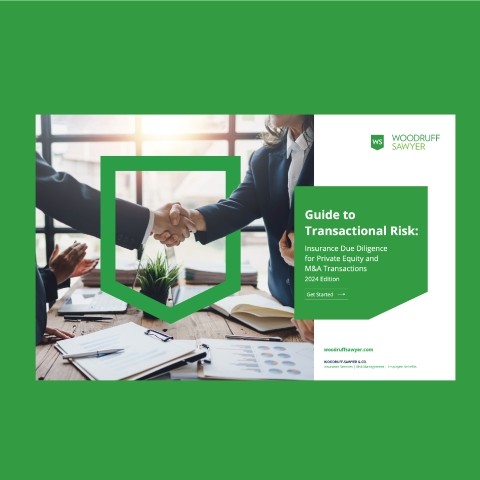Guide
Managing Transactional Risk in 2024: A Strategy Guide
As we move further into 2024, we have a clearer perspective on where 2023 ended in the private equity and mergers and acquisitions (M&A) market. We predict more of the same throughout 2024, but there are bright signs for dealmaking this year.
According to EY’s “Private Equity Pulse,” inflationary headwinds, rising interest rates, geopolitical unrest, and general macroeconomic uncertainty led to dealmakers largely tapping the brakes throughout 2023. However, even though 2023 was a tough deal environment, it was still the third most active year on record in terms of total deal count.
Woodruff Sawyer’s 2024 Guide to Transactional Risk: Insurance Due Diligence for Private Equity & M&A explains how we help our private equity, growth equity, special purpose acquisition company (SPAC) and de-SPAC, and strategic acquirer clients through their transactions. Here are some highlights from our new guide.
Bright Signs for the Deal Landscape
The good news is that deals, albeit on the smaller side, are still getting done via add-on acquisition or growth equity structures as opposed to traditional buyouts.
Based on our historical experience of cyclical trends in private equity deals and our research, we believe the deal landscape will improve in Q2 and Q3 2024. At some point, exit activity must pick up, which will spur additional fundraising efforts.
With record levels of dry powder and new, recently closed buyout funds across the industry, we believe firms will find a way to get deals done in 2024. However, we expect investment teams will spend more time analyzing what’s under the hood of a potential target acquisition in 2024 than they may have in previous years, and deals may take longer to close as a result.
Why Due Diligence is Essential
Drawing from over 25 years of experience working in the private equity and M&A community, we at Woodruff Sawyer recommend performing insurance due diligence on every transaction to identify, quantify, mitigate, diminish, or otherwise transfer the potential risks that could negatively affect EBITDA for the portfolio company.
Our 2024 Guide to Transactional Risk explains how we help our private equity, growth equity, and strategic acquirer clients through their transactions. Here’s how insurance due diligence benefits your team on any transaction.
- Uncover potential land mines that can negatively affect EBITDA for a target acquisition in both the short and long term.
- Understand the foundation of insurance, general risk management strategy, and approach to employee benefits offerings that protect the business and employees before an acquisition.
- Watch for implications on the total cost of risk.
- Uncover opportunities for cost structure improvement post-close.
- Avoid exclusions or issues with the representations and warranties insurance (RWI) process.
- Understand historical losses.
- Coordinate run-off policies.
- Get a sense of evidence-based benchmarking.
- Know what value-added resources are being offered.
- Identify potential new program needs.
- Respond to lender requests.
- Enhance a deal team's understanding of the target acquisition pre-close, ensuring no surprises come up post-close.
The Transaction Timeline from an Insurance Perspective
The two main insurance-related workstreams are the RWI and due diligence processes. Understanding how these two simultaneous workstreams weave into the broader transaction timeline will help you avoid delays at the end of the process.
Here is the typical process for a stock buyout transaction:
Phase 1: Pre-LOI Through Execution of LOI
The pre-LOI period is often when a buyer engages an RWI broker to approach the marketplace to obtain quotes for the transaction. This first phase includes submitting several pieces of key information to the broad RWI marketplace.
LOI Best Practices from an Insurance Perspective:
- Involve your insurance advisor early in the deal process.
- Include a vetted RWI proposal with first- or second-round bid packages.
- Complete administrative work on the due diligence side to prepare for diligence to begin.
- Get familiar with the target company by reviewing the Confidential Information Memorandum, financials, management presentations, and initial insurance-related information.
Phase 2: Period of Exclusivity and Insurance Due Diligence
Once the LOI has been executed and the deal moves into exclusivity, the buyer will kick off all third-party diligence workstreams.
First, the diligence team becomes acquainted with the target company by having a call with the management team to provide clarity on the insurance process and answer any insurance checklist-related questions. As more information supplied to the buyer’s team, the insurance diligence team begins work on the due diligence.
The insurance advisor should be considered an extension of the deal team and a partner in EBITDA protection, risk mitigation, and overall insurance strategy.
Phase 3: Pathway to Close and Closing
Once the initial due diligence is completed, several things need to happen prior to closing.
- RWI Phase II underwriting process
- Coordination of run-off coverage for any policies that have a change in control provision
- Go-forward coverage solicitation
- Certificate of insurance coordination
Phase 4: Post-Close Brokerage and Implementation
Now the real work and partnership begin between the operating partners of the private equity firm, the management team of the newly acquired company, and the insurance broker team. Post-close is when the advisor begins implementing any recommendations that could not be or were not implemented at close.
It is also when the due diligence advisory team works with the management team to develop a comprehensive insurance and risk management strategy for the short, medium, and long term.
5 Key Insurance Due Diligence Findings
Here are key findings that Woodruff Sawyer sees in middle-market private and growth equity transactions.
- No comprehensive, strategic approach to insurance and risk management. The insurance advisor should recommend ways to both professionalize the program and raise the level of sophistication of the insurance program post-close to maximize EBITDA protection over the lifecycle of the investment.
- Key coverages are missing. Examples include directors’ and officers’ liability, commercial crime, cyber liability, and product recall liability.
- Limits are inadequate: We have found the company typically has not performed any benchmarking analysis around limit adequacy. Examples of coverages with inadequate limits include cyber liability, business income and extra expense, contingent business income, and product liability.
- RWI continues to be used on most transactions, and it's becoming the norm even on deals smaller than $50 million. There is a lot of discussion and marketing around contingent risk and litigation risk, and tax continues to be a focus. Cyber liability continues to be the underwriter’s greatest concern when looking at insurance diligence and is worth exploring early in the quoting process.
- Management teams should expect varying premium/rate increases depending on product and industry on property, casualty, and management liability coverages. While the cyber liability market is normalizing, the commercial property marketplace continues to be in tough shape, given the catastrophic events throughout 2022.
For an in-depth look at the insurance due diligence process and how it can help you close deals faster and with more certainty, view or download your copy of the Guide to Transactional Risk: Insurance Due Diligence for Private Equity and M&A.
Authors
Table of Contents


















